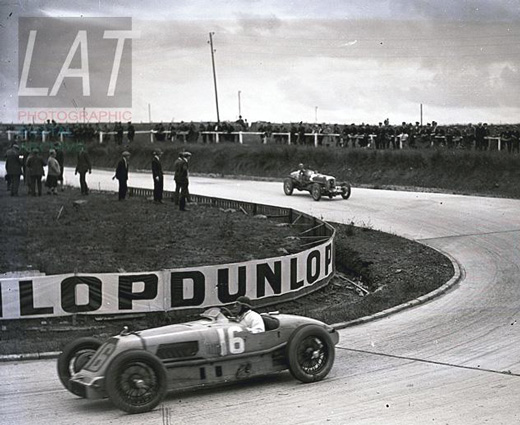
Louis Wagner in the 1.5 GP Talbot Darracq at the 1927 French Grand Prix, where he broke the lap record.
Photo courtesy of LAT via Austin Harris
By Pete Vack
An International Effort
Sunbeam-Talbot-Darracq, or STD for short, was a strange combination of French, British, Italian concerns, money and talent. To put it briefly if not perfectly accurately, in 1919, the British firms of Sunbeam and Talbot merged and in 1920, the two further merged with the French firm of Darracq. At the time, a prime force behind the boardroom doors was a mechanical engineer by the name of Louis Coatalen.
Born in France in 1879, Coatalen (coat-a-len) migrated to England in 1901 and joined Sunbeam in 1907. By 1919 his work on both automobile and airplane engines had made both Sunbeam and Coatalen wealthy; Sunbeam’s merger with the firms of Talbot and Darracq enabled Coatalen to return to France and set up headquarters in a Paris suburb of Suresnes, and thus began the saga of STD.
Two engineers were lured from Fiat; Vincenzo Bertarione and Walter Becchia arrived in Suresnes, France in 1922 and immediately began to design a series of engines largely based on their Fiat experiences. This cross pollination was not unusual: Coatalen himself, or so the story goes, obtained a Grand Prix Peugeot in 1914, stripped it down at his home, and voila, the Sunbeam DOHC Grand Prix car was the result.
Competitive but confusing
A successful series of racing cars were produced in the next five years, but the confusing array of international mergers was often detrimental to public relations. Griff Borgeson believed that because the new holding company had a chaotic way of naming their cars, “..it helped to create the enduring impression that the marque was mediocre in the racing field.” It was badge engineering with a nationalistic twist; Sunbeams were built in Great Britain, as was the Sunbeam Talbot (after 1938), while the Talbot Darracq and Darracq were built in France. Wrote Borgeson, “If they are looked on as the tools or toys of the same single guiding genius [Coatalen] their record becomes quite impressive.” The 1921 3 liter Grand Prix Sunbeams were successful and run as both Sunbeams and Talbot Darracqs. In 1923-4 smaller but related four cylinder 1.5 liter Talbot Darracqs won seventeen voiturette events in a row. For the 1922 two liter formula, the STDs were equipped with a Fiat 404 clone DOHC six and were called “Fiats in green paint”. These won the French GP in 1923 and supercharged won again in 1924 as Sunbeams. Confusing but to the board a win was still a win. Based upon these successes, STD would embark upon a new straight eight design for the 1926 Formula.
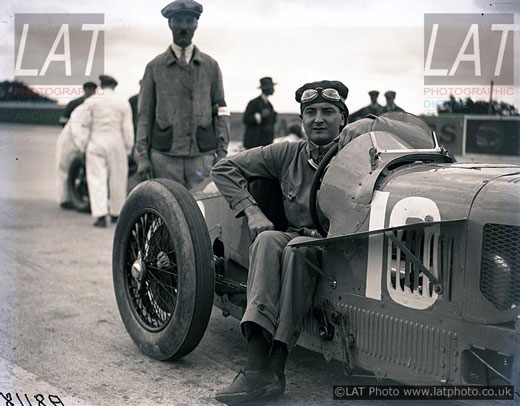
Jules Moriceau in the cockpit before the start of the 1927 French Grand Prix. Photo courtesy of LAT via Austin Harris
It would be nice to relate that the superb Talbot Darracq Grand Prix cars were runaway winners, dominating the new formula, or even runners up in the Grand Prix formula of those roaring twenties.
___________________________________________________________
If you are enjoying this article, why not consider a donation to VeloceToday? Click here for details..it’s easy!
___________________________________________________________
But they weren’t. Yet we can’t blame the car or the design itself. It was one of those elusive, “If only” caveats of history. Instead, the most advanced car built by the Coatalen-era STD would be plagued with reliability issues as well as competing in what was at best an unpopular formula, dominated by the very similar Delage. Lack of funds kept development at a slow pace, part of the viscous circle that started with embarrassingly poor showings.
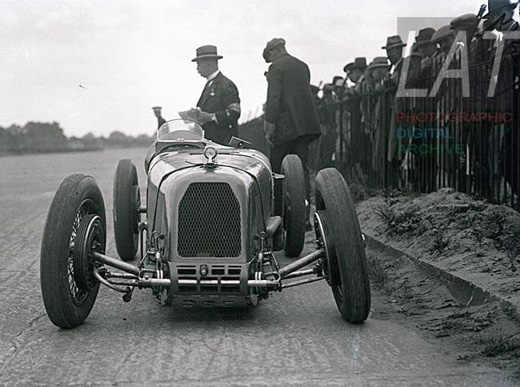
A broken front axle put Moriceau out of the 1926 British Grand Prix.
Photo courtesy of LAT via Austin Harris
The Talbot-Darracq 1500 would be the swansong of the marque; the cars would be campaigned by Scuderia Materassi from 1928-1930 during the years of the Formula Libre and finally showed results, winning a number of first in class and overall victories primarily in the hands of Materassi himself. Tragically, he was killed at Monza along with 23 spectators. There was a bright moment as Tazio Nuvolari drove one of the cars to a second overall at Monza in 1929 but he left for greener pastures. The team soldiered on under Brilli Peri and Biondetti but the cars were already uncompetitive by the time Enrico Plate bought and modified two of the cars in 1932. The record, then, as compiled by Alain Spitz. (Talbot, des Talbot-Darracq aux Talbot-Lago, 1983).
The 1926-1928 Formula
1500 cc supercharged
Weight limit, 600 kilos dry, raised to 700 kilos in 1927.
Primary results for the Talbot-Darracq
1926
(The Talbot Darracqs did not enter the first three Grand Prix races of the year. )
August 7th Brooklands British Grand Prix
Seagrave set fastest lap at 138.36 km/hr, but retired with ignition problems
Moriceau retired with broken front axle
Divo, retired when engine did not restart in pits.
September 7th, Arpajon Records Day
Divo, new records in International 1500 class, Flying kilometer and Flying mile.
September 25th Brooklands, JCC 200
1st Segrave
2nd Divo
13th, Moriceau
No Delages were entered in this event
October 17th Coupe du Salon, Montlhery
1st Divo
2nd Segrave
3rd Moriceau
1927
March 27th MIramas, GP de Provenance
Moriceau and Williams first and second in heat, but cars were withdrawn after dispute
July 2nd and3rd Montlhery, GP d L’ACF
Divo, 1st in Formula Libre event on Saturday
Williams and Moriceau 4th in 1.5 Grand Prix event on Sunday (Delage took the first three places)
September 4th Arpajon Records Day
Divo set a new 1500 cc record for the Flying Mile.
After Montlhery and the total domination of the Delage team, the STD board colosed the racing department and sold the three cars to Scuderia Materassi.
1928 (Scuderia Materassi of Italy, Formula Libre)
April 23 Alexandria, Grand Prix
Materassi 1st in 1500 class, 4th overall
June 10th GP Royale de Roma
Materassi, 1st 1500 cc class
June 30 Circuit di Mugello
Materassi, 1st 1500 class, 3rd overall
August 4th Coupe Acerbo
Materassi, 2nd
August 19th, Cicuit di Montenero
Materassi, 1st in class, 1st overall
September 9 Monza, GP of Europe
Arcangeli, 4th overall and fastest lap
Materassi was killed along with 23 spectators
1929 (Scuderia Materassi)
March 24 Tripoli, Grand Prix Mellaha
Brilli Peri, 1st
May 26 GP Royale Roma
Arcangeli, 1st 1500 cc class, 4th overall
June 9th Circuit di Mugello
Brilli Peri, 1st
July 21 Circuit di Montenero
Arcangeli, 1st 1500 cc class and 1st overall
September 15 GP di Monza
Archangeli 1500 cc 1st
Nuvolari, 1500cc 2nd and overall 2nd
1930 (Team was now led by Brilli-Peri)
March 23 Tripoli Grand Prix
Brilli-Peri killed in practice
Biondetti, 1st 1500 cc class, 3rd overall
April 6th Monaco
Biondetti, DNF
June 1 Livorno
1st 1500 cc class, Brivio?
Pescara, Coppa Acerbo, Brivio, 4th, Biondetti DNF
September Monza Neither Biondetti nor Brivio qualified for final
Below, current owner Stuart Anderson enjoys the results of a twenty year restoration at the Phillips Island Classic Festival
In March of 2009. Our thanks to Stuart for the help in putting together this series of articles in VeloceToday. All photos below by Vince Johnson.
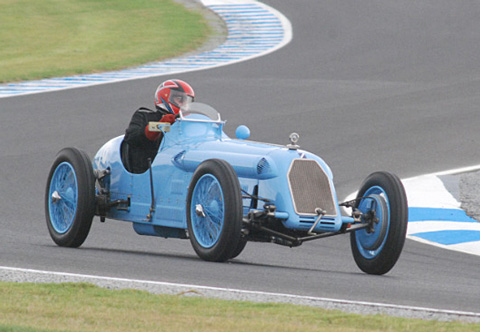
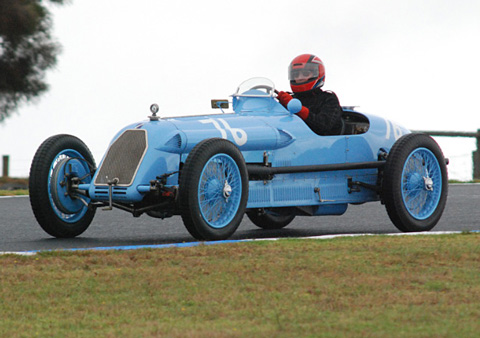
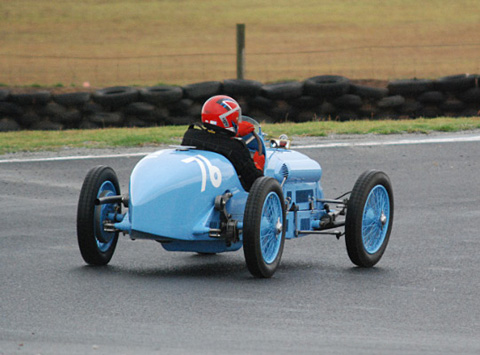
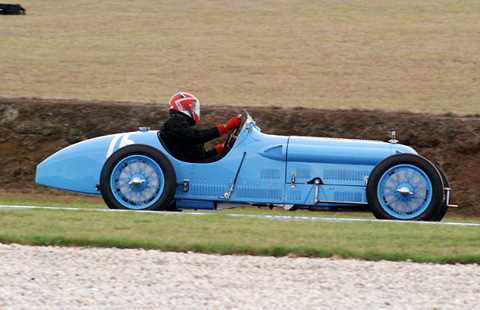
Sources
The Classic Twin Cam Engine, Griffith Borgeson, Dalton Watson
Talbot, des Talbot-Darracq aux Talbot-Lago, Alain Spitz
The Racing Fifteen Hundreds, David Venables
The Complete Encyclopedia of Motorcars, Georgano
The Encyclopedia of Motor Sport, Georgano
Classic and Sportscars, March 1996
For more on the Talbot Darracq, click on the images.
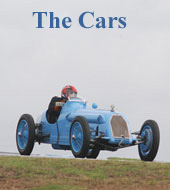
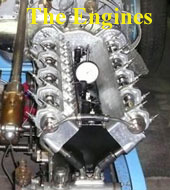
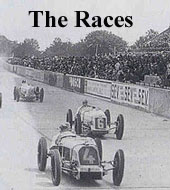
Was this car at the Portland International Raceway in September of 2009? I recall a “Talbot” at least similar, in attendance. They are beautiful machines, and Mr. Anderson’s painstaking restoration is most appreciated.
The picture captioned as showing Moriceau in the cockpit of the car is actually “Williams”, although Moriceau was the nominated reserve for the Talbot team and did share the driving of this car.